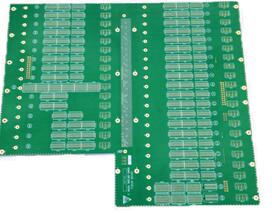In the PCB design of the circuit board factory, the impedance problem is an inevitable problem. Then, what details should the circuit board factory pay attention to when calculating the impedance in the PCB design?
1. The line width is rather wide than thin.
Because there is a fine limit in the manufacturing process, there is no limit to the width. In the later stage, in order to adjust the impedance, when the line width is fine-tuned and reaches the limit, it will be troublesome, which will increase the cost or relax the impedance control.
2. There is a trend as a whole.
The circuit board factory may have multiple impedance control targets in the design, so the overall size is too large or too small, and there is no need to be too large or small out of sync.
3. Consider the residual copper rate and the amount of glue flow.
When one or both sides of the prepreg are etched circuits, the glue will fill the etched gaps during the pressing process, so that the glue thickness time between the two layers will be reduced. The residual copper rate and the amount of glue flow are not calculated correctly, and the dielectric coefficient of the new material is inconsistent with the nominal value, and signal integrity problems may occur.
4. Specify the glass cloth and glue content.
The dielectric coefficient of different glass cloth, prepreg or core board with different glue content is different, even if it is about the same height, there may be a difference between 3.5 and 4. This difference can cause a single-line impedance change of about 3 ohm.
What is the difference between lead-free tin spraying and lead tin spraying on HDI factory circuit boards?
With the continuous development of the electronics industry, the technical level of HDI plants is also rising. Common surface treatment processes include tin spray, gold immersion, gold plating, OSP, etc.; among them, tin spray is divided into lead-free tin spray and lead-free tin spray. So, what is the difference between lead-free and lead-free spray tin on PCB circuit boards of HDI factory?

Lead-free tin spraying belongs to an environmentally friendly process, does not contain harmful substances "lead", the melting point is about 218 degrees; the temperature of the tin furnace needs to be controlled at 280-300 degrees; the wave soldering temperature needs to be controlled at about 260 degrees; over reflow soldering The temperature is around 260-270 degrees.
2. Lead spraying is not an environmentally friendly process, and contains harmful substances "lead", with a melting point of about 183 degrees; the temperature of the tin furnace must be controlled at 245-260 degrees; the temperature of wave soldering must be controlled at about 250 degrees; the temperature of over reflow soldering Around 245-255 degrees.
3. From the surface of tin, lead-tin is brighter, and lead-free tin is faint; the wettability of lead-free board of HDI factory is a little bit worse than that of leaded board.
4. The lead content of lead-free tin does not exceed 0.5, and the lead content of leaded tin reaches 37.
5. Lead will increase the activity of the tin wire during the soldering process. The lead-tin wire is better than the lead-free tin wire; however, lead is poisonous, and long-term use is not good for the human body. Lead-free tin has a higher melting point than lead tin, and the solder joints will be much stronger.
6. In the surface treatment of PCB boards, the price of lead-free tin spraying and lead tin spraying is usually the same, there is no difference.